Expand the sections below to see Local OPERA Program projects completed by year.
2024
Winter Road Sand Treatment
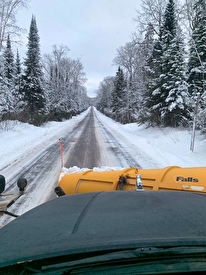
Cook County Highway Department maintenance staff reduced total road salt use by 12.5% in an experiment without significant equipment changes that substituted potassium acetate-treated sand on one plow route for its regular salt/sand mix.
2022–2023
The Otter Claw
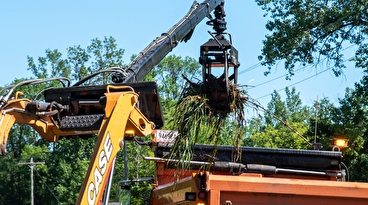
Otter Tail County Highway Department maintenance staff developed an extendable culvert cleaner attachment for a skid steer to easily and safely remove large amounts of debris in as little as 10 minutes from culverts and ditches, around bridges, and in other previously hard-to-reach locations.
Road Shouldering Machine Improvements
Redwood County Highway Department staff improved the design of a new road shouldering machine with innovative repairs following extensive damage by a gravel supply truck. An added angle iron deflector has been successful in shifting the truck tailgate pins away from the machine's frame, preventing further damage and the resulting downtime.
Winter Weather Monitoring System
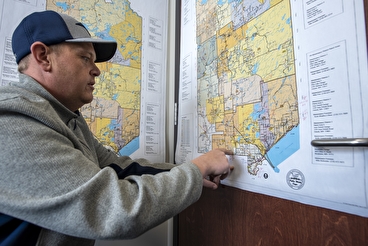
St. Louis County Public Works Department staff developed a cost-effective network of remote cameras to monitor winter road conditions on 3,000 miles of county roads to save maintenance costs and improve road user safety.
Snowplow Brine Tank System
Rochester Public Works Department staff modified their snowplow brine system by adding a "nurse" tank to ensure operators can apply prewetted salt throughout an entire plow event for enhanced effectiveness in melting snow and ice.
2021
Trail Plow Cutting Edges
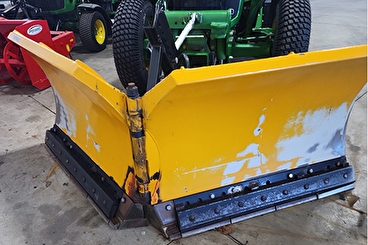
City of Eagan Public Works staff found using tungsten carbide cutting edges instead of standard steel on trail plows could provide a net reduction in replacement costs over the life cycle of the cutting edge while maintaining the quality of snow removal.
2019–2020
Temporary Roadside Turf Irrigation System
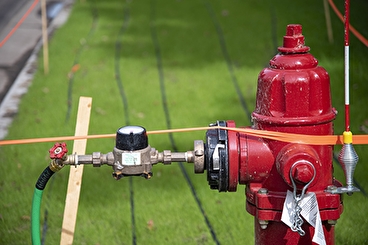
The City of Edina Engineering Department built and tested a temporary roadside turf irrigation system with inexpensive common parts for the roadsides of a smaller city road and utilities reconstruction projects as a more efficient and cost-effective alternative to water truck irrigation.
Otta Seal Surface on an Unpaved Granite Road
Franklin Township in Wright County experimented with a relatively inexpensive asphalt surface treatment, known as Otta seal, as a way to reduce maintenance costs and improve ride quality on its high-traffic gravel roads with a crushed granite base.
Side-Dumping Plow Truck
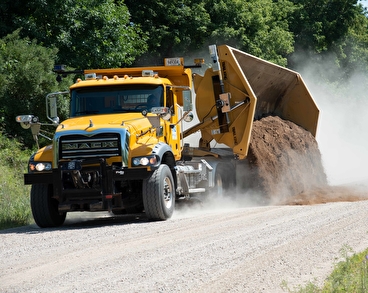
Nicollet County Public Works staff found a way to significantly increase its legal hauling capacity and, as a result, greatly improve its operating efficiency by adapting a plow truck to also haul a side-dumping trailer.
Traffic Signal Preemption for Snowplows
The City of St. Cloud Public Works Department has realized a significant improvement in snowplow travel times using traffic signal relative priority preemption technology. The system also provides many more safety and operational benefits.
Sand-Stabilized Dirt Roads
The Kittson County Highway Department produced a significant reduction in rutting on a typical dirt farm road by topping it with a layer of sandy Class 3 aggregate. Such roads often becomes impassible with severe rutting after a summer rain or when exposed to heavy agricultural loads.
Evaluation of a Cement-Stabilized Gravel Road
McLeod County evaluated a cement-stabilized gravel road with a double chip-seal surface for potential causes of its poor performance and to determine potential repair and rehabilitation options.
2017–2018
Otter Plow Cushion
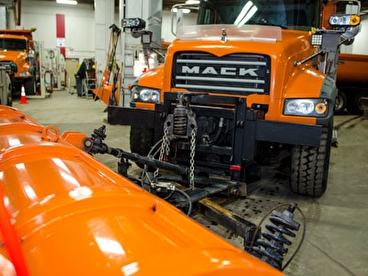
The Otter Tail County Highway Department created this device to absorb the shock of rough roads on the snowplow assembly and lift chains, improving ride quality and reducing the failure of the plow lift chains and parts.
Evaluating Pickle Brine for Ice Control
Carver County Public Works maintenance operations staff are searching for new options to reduce the amount of chloride that reaches our waters from road salt operations. Using food production byproducts such as pickle brine are among the alternatives maintenance staff have been exploring.
Pollinator Habitat Along Roadsides
Washington County public works staff, in collaboration with the Washington Conservation District, are testing four different methods of site preparation and seeding to determine which is the most effective and efficient way to increase floral resources for pollinators along roadsides.
Retrofitting Bridge Approach Transition Curbs
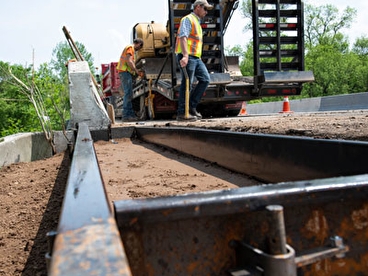
To address the problem of washout erosion along the wing walls of bridges, the Jackson County Public Works Department developed a bridge approach transition curb that has been included on all new bridge construction for the last 10 years. In this project, the county developed a process for adding the feature to older bridges, including the design and fabrication of reusable custom metal forms.
Biobased Sealant for Bridge Decks
Most bridge sealants are quite toxic and contain many compounds that can be dangerous. The City of Hutchinson wanted a more environmentally friendly and operator-friendly option for sealing bridge decks. In this project, the city tested an Opti-SEAL™ product from BioSpan Technologies that is 90% biobased.
Project Management with BrightWork
Carver County Public Works uses Microsoft Project® to manage construction project schedules, but only for large projects. MS Project requires training and is cumbersome for smaller projects. Staff were looking for a project management software scalable to a project’s size and scope, so the department purchased, installed, and tested BrightWork, a project management add-on for Microsoft SharePoint.
Pavement Management Software Evaluation
St. Louis County Public Works is piloting a new system to better manage its paved highways. StreetSaver is cloud-based pavement management application that allows use in multiple environments, along with an option to export data for in-house analysis. The mapping portion of the application is much more user-friendly with more available features and functionality than ICON, the software currently used to manage the paved road system in St. Louis County.
2015
Trail/Road Coating for Snowmobile Crossings
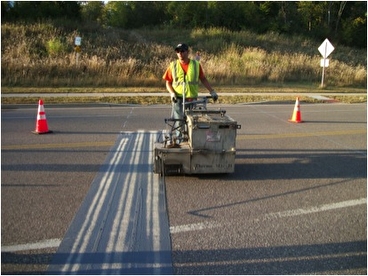
Scott County installed a thermoplastic coating to protect roads and trails at snowmobile crossings, where pavement damage often requires early repairs.
Reptile Crossing
Washington County installed a specialized culvert to allow turtles and other reptiles to safely cross a busy highway. They also installed a fence designed to funnel the turtles into the tunnel. The installation also prevents traffic hazards since drivers no longer stop to help turtles cross the highway.
Asphalt Tailgate Extension
Cottonwood County designed a covered gate for its hot-mix asphalt truck. The gate controls the amount of material being distributed and prevents the mix from losing heat.
Ultra-thin Bonded Wearing Course Over Micro-Milling Test Section
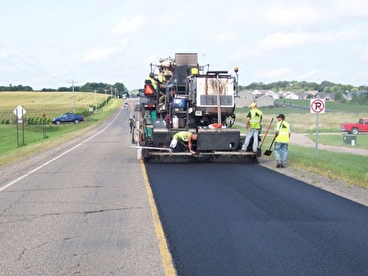
McLeod County surfaced a section of CSAH 155 with a 5/8-inch-thick ultra-thin bonded bituminous wearing course in lieu of a traditional seal coat. It provided a significant improvement in ride quality and provides a quiet ride.
Skid Loader Attachment Flatbed for Hook Truck
The City of Golden Valley purchased and fabricated a flatbed hook body that uses the SwapLoader system to transport its skid steer and a variety of attachments. It allows the city to efficiently transition between different assignments throughout the course of a day.
Urban Snow Support Vehicle
The City of Golden Valley fabricated a flatbed hook body that uses the SwapLoader system to transport a variety of equipment and tools for snow and ice control tasks. This allows staff to respond to events more quickly by eliminating the need to return to the shop between tasks to collect different equipment.
Concrete Form Hook Box
The City of Golden Valley purchased and fabricated a concrete form hook box to organize and transport its tools, materials, and equipment. This improved the city's efficiency because all concrete forms and tools are now organized, secured, and available on site.
Bobcat Asphalt Curb Machine
The City of Wabasha built an asphalt curb machine to help replace deteriorating curbs and reduce man hours.
2014
Versatile Spraying Unit
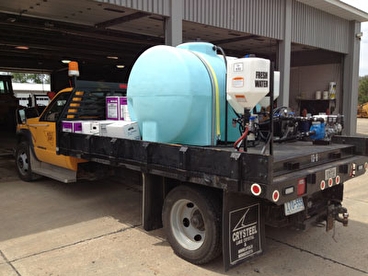
Nicollet County’s existing method of spraying noxious weeds and brush sites was slow, unsafe,
and inefficient. In response, the county designed and fabricated a versatile spraying unit. The unit consists of a mountable platform that contains tanks, hoses, and a pump, which can be easily installed on and removed from an existing flatbed one-ton county pickup truck.
Back-up Sensor Technology for Snowplows
When Stearns County drivers have to back up large trucks, they are challenged by a large blind spot. It can be difficult for drivers to ensure that the path behind the truck is clear. To address this problem, the county installed Precise View back-up systems on three tandem dump trucks in 2013.
Evaluating Local Road Rehab Alternatives
Brown County conducted pavement strength and performance analysis on thin HMA overlays and chip-seal surface treatments over recycled stabilized bases. The county also identified pertinent research to characterize the various stabilization treatments and how they might perform in relation to the overlay or chip seal.
Vinyl Wrap for Paint Truck
The Sherburne County paint crew is always given the worst truck of the fleet since it is likely to get paint on it during painting operations. The county installed a vinyl wrap on the box and tailgate of a pickup truck. This allowed the paint crew to have access to a newer truck with better strobes and an extended cab.
Evaluation of Expanded Polypropylene Rings for Manhole Grade Adjustment
Eden Prairie installed new polypropylene (foam) plastic manhole rings in its town center. These rings are lighter and more durable than concrete and offer more versatility than hard plastic rings, since they can be easily stacked or staggered when necessary.
Roadway Shouldering Machine Modification
Otter Tail County’s shouldering machine was mounted on the front of its motor grader. The machine required two people to operate, with one person sitting in a very unsafe position out on the shouldering machine. The county rebuilt the machine so it can be mounted on a John Deere loader and operated more safely by a single operator.
2013
In-Pavement LED Pedestrian Crossing Operations and Effectiveness
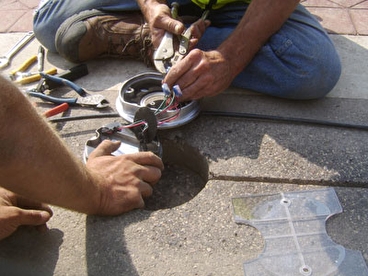
The City of St. Anthony Village installed a pedestrian-activated in-pavement lighting system designed to increase driver compliance in yielding the right-of-way to pedestrians at a potentially dangerous mid-block crossing. The system warns motorists as they are approaching the pedestrian crossing when it is occupied by pedestrians or about to be occupied by pedestrians.
Nonintrusive Road and Weather Information System
During night and weekend weather events, staff at the City of Eden Prairie had a difficult time determining when a full deployment of personnel was needed for snow and ice removal. To facilitate decision making, the city installed a Vaisala road and weather information station that provides real-time information on weather conditions and the current grip level of the roadway
Traffic Control Response Trailer
The City of Lakeville Streets Division purchased a trailer and fabricated racks to store barricades and other traffic control devices. The trailer has helped the city to better store its traffic control devices, improve its response to traffic control and barricade placement needs, and save time and labor costs.
Sign Inventory Storage Cabinets
Olmsted County lacked the ability to efficiently store and maintain its sign inventory. The county developed a durable storage cabinet system that vertically stores the county's multiple sizes and shapes of signs. The system allows for easy access and protects the sign sheeting from damage.
Chip Seal over Gravel Road
Silver Creek Township wanted a more affordable solution that could help reduce maintenance costs for gravel roads that have low traffic volumes and primarily serve residential homes and farms. The township applied a flexible chip-seal mat on four miles of gravel roads, which has made the roads smoother, ride better, and less muddy and dusty.
2012
Skid Loader Bituminous Screed
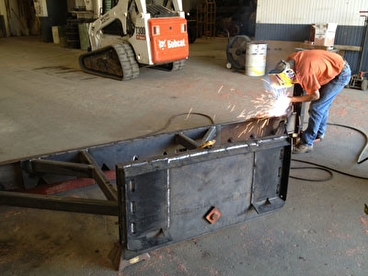
Murray County built a wide-screed skid loader attachment to improve the quality of its bituminous patching over large areas. The screed slides on hydraulically maneuverable skids that can be raised or lowered depending on the desired thickness of the patching material.
Evaluation of Deicing and Anti-Icing Technologies
The City of Grand Rapids assessed the operational efficiency of two alternative deicing technologies: tailgate spreaders and an Epoke bulk spreader. The city compared the performance of the spreaders on two equivalent routes, specifically examining the difference in material usage, time to complete the route, and roadway condition after deicing.
Sustainable Pavement Rehabilitation Using Thin Bonded Overlay Constructed with High Taconite Mix
The City of Duluth constructed three roadway test sections to evaluate the performance of thin bonded overlay mixes containing taconite tailings, a locally available mining byproduct.
Snow and Ice Products for Bituminous Trails in Recreational and Critical Areas
To improve winter maintenance service delivery on segments of residential bituminous trails and sidewalks, the City of Waconia began treating these areas with anti-icing and deicing winter maintenance liquids. The project included the creation of an application unit as well as the use of a blending station for winter maintenance liquids. Overall, the project allowed the city to reduce material use and staff time and to eliminate trail closures and safety issues.
Development of Aggregate Loss Factors for Rural Gravel Roads
Itasca County began collecting field data to measure gravel loss caused by traffic and winter maintenance activities. After four years of data collection, the information will be used to develop aggregate loss factors that can be used to predict annual gravel needs for a variety of roadway characteristics.
Greener Bituminous Pavements
Lake County developed potential reclaimed asphalt pavement (RAP) mixes containing imported, high-quality aggregates that could be tested in a low-volume pavement project. These mixes allowed the county to reduce costs by using less new asphalt while also using surplus RAP material available from local surface renewal projects. The addition of high-quality aggregates also provided a more durable bituminous surface than current mixes.
Implementation of an Anti-Icing Calibration Unit
The City of Golden Valley purchased an anti-icing calibration unit so its trucks could be calibrated for consistent salt and sand application. The goal of the project was to reduce the city’s material use, resulting in both a cost savings to the city and benefits to the watershed and surrounding environment.
2011
Rehabilitating/Upgrading Low-Volume Roads with Waste Shingles
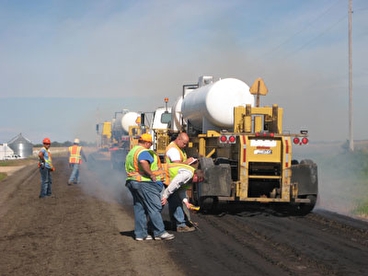
Blue Earth County completed a gravel road stabilization project on a section of County State Aid Highway 48 using a blend of recycled asphalt shingles and recycled asphalt pavement rather than the typical stabilizing binder used in past projects. The county plans to observe the performance of the shingle mix for one to two years.
Implementation of a Scale-Tec Calibration Scale
Olmsted County used a Scale-Tec Calibrator to correctly calibrate the amount of salt and sand being applied by each of its 17 snowplow trucks. By measuring the weight of the discharged material, the calibrator helped the county determine the appropriate settings for each spreader and ensure the correct and consistent application of salt and sand.
Taconite-Enhanced Pothole Repair Using Portable Microwave Technology
The University of Minnesota Duluth’s Natural Resources Research Institute partnered with Anoka County and St. Louis County to test the repair of potholes and damaged pavement with mobile microwave technology. Materials used included recycled asphalt pavement/millings, microwave-absorbing taconite materials, and recycled asphalt shingles.
Innovations in Microsurfacing Materials and Application Techniques
In an effort to improve the properties of microsurfacing for better performance on county roadways, Wright County partnered with Road Science to test a new flexible microsurfacing product on portions of two county roads. The new material was designed to improve the crack resistance of pavement compared to traditional microsurfacing.
Use of Laser Scanning Technology to Obtain As-Built Records of Historic Covered Bridges
The City of Zumbrota used laser-scanning technology to complete three-dimensional scanning and data processing of the Zumbrota Covered Bridge, the only remaining historic covered bridge in Minnesota. The information was used to assemble a complete digital representation of the bridge and to generate a 1/100-scale three-dimensional replica.
CAD Drawing of a Simple Salter/Sander Chute
Washington County fabricated a simple salter/sander chute to facilitate more accurate and precise salt and sand placement on roadways. Accompanying CAD drawings were created to allow other agencies to easily fabricate, install, and adjust the salter/sander chute. Washington County is now using chutes on a trial basis, with plans to install them on more trucks in its fleet.
- Fact sheet (PDF)
- CAD drawing #1 (PDF)
- CAD drawing #2 (PDF)
- CAD drawing #3 (PDF)
- CAD drawing #4 (PDF)
- CAD drawing #5 (PDF)
- CAD drawing #6 (PDF)
Stormwater Pollutant Removal in Rain Gardens
The City of Grand Rapids constructed modified rain gardens as part of a street reconstruction project. The gardens were connected and allowed to discharge to the city's storm sewer system. Although not as large as traditional rain gardens, these modified gardens have potential as a best management practice for reducing stormwater pollutant discharge to receiving bodies of water.
Minnetonka "Winter Green" Initiative
The City of Minnetonka began a “Winter Green” initiative after being notified that it was exceeding its maximum chloride loading standards by the Nine Mile Creek Watershed District. The initiative included an aggressive and comprehensive training program as well as the purchase and installation of upgraded equipment.
Advanced Deicing Product Testing
The McLeod County Highway Department tested the use of IceSlicer™ granular deicing material. The department found that the IceSlicer™ material allowed for reduced material usage—about half as much material was needed compared to traditional white salt. The department also found the cost to be comparable to salt when the reduced usage of material was factored in.
Installation and Early Performance of Mastic Patches on City Streets
The City of Bloomington partnered with the City of Minnetonka to compare the performance of mastic products to that of traditional bituminous patching. The materials were used to repair potholes and transverse cracks, and results indicate that mastic products successfully restored ride quality to both types of deterioration.
Catch Basin Maintenance/Repair Trailer
The City of Lakeville Streets Division modified an existing trailer for use in catch basin repairs and maintenance. All the necessary equipment and materials are readily available, including a service crane and cement mixer installed directly on the trailer. Although designed specifically for catch basin repairs, it can also be used for sidewalk repairs, water main repairs, sewer casting adjustments, and other projects.
Application of Replay® Agricultural Oil Seal and Preservation Agent
The City of Hutchinson used Replay®, an agricultural oil seal and preservation agent that contains no petroleum, to seal two sections of asphalt pavement. After the application, visual inspections indicated that the top layer of asphalt had been sealed. Unlike other sealants, Replay® did not become sticky in hot weather, making it ideal for areas experiencing high volumes of pedestrian traffic during the summer.
2010
Evaluation of Grader Front-Mounted Retriever Hitch
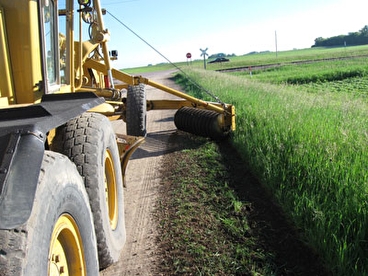
A front-mounted retriever was used on gravel roads and bituminous roads with gravel shoulders, allowing one motor grader to perform reclaiming and blading operations in a single pass. The retriever offered better visibility and prevented most of the reclaimed material from being thrown too far onto the roadway surface.
Magnesium Chloride Dust Coating Evaluation
Magnesium chloride was applied to a county road to help decrease material and maintenance costs. The application eliminated the need to apply a biennial resurfacing aggregate layer and reduced the need for maintenance blading operations in areas of light traffic.
City of Eagan Automated Vehicle Location
Maintenance managers have historically been challenged to allocate and reallocate resources during winter snow and ice control operations. Equipping the city’ s winter vehicle fleet with automated vehicle location technology allowed managers to observe real-time operations from any computer terminal and adjust resources immediately via telephone and radio communications.
Cushion Release Push Frame and Weight Transfer Kits
One Cushion Release Push Frame and two Weight Transfer Kits were installed on snow blowing and lawn mowing equipment. The Push Frame assisted the tractor-mounted snow blower in continuously scraping the surface being cleared, and the Weight Transfer Kits permitted operators to increase traction by shifting weight to the drive wheels.
Brunswick Township Erosion Control Project
When a tire fill was used to repair an old corduroy road, a silt fence was required between the construction area and a nearby swamp to prevent damaging the wetland. The stabilization fabric beneath the tire fill was extended to the construction limits and attached to stakes, forming a positive erosion control barrier.
U.S. National Grid Field Marker Prototyping
The City of St. Paul investigated the methodology and equipment necessary to inexpensively mark infrastructure in the field with U.S. National Grid location data. A system for generating portable markers in the field and a marker-reading application for end users was developed, and smart phones were used to obtain grid locations and drive a printer to create field markers.
GPS/AVL Tracking and Mapping
A low-cost, flexible alternative to traditional automated vehicle location systems was developed using Nokia N900 cellular phones, off-the-shelf Linux-based hardware, and open source tools. The system is designed to help medium and small communities track their mobile assets.
Ultra Guard Cart Test
The Ultra Guard Cart, a handheld device that can paint a 6-inch retro-reflective stripe on vertical surfaces, was used to paint guardrails on several types of curves. The cart was easy to use and adjust for different types of barriers, and paint stripes applied by the cart have shown less vulnerability to damage.
2005–2009
Visit the OPERA annual report archives for details on projects completed between 2005–2009.